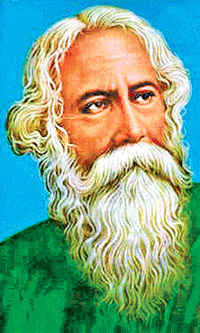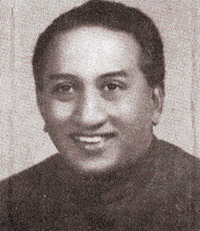Gurudev, Sri Palee and the cultural renaissance
Yasasiri JANAKA KUMARA
Seventy seven years ago, on May 20, 1934 Gurudev Rabindranath Tagore
laid the foundation for Sri Palee College, enrolled the first four
students, saw a performance of Kandyan and low country dances before
addressing the simple village folks of Horana.
|

Rabindranath Tagore |
"It reminds me of my own work in Bengal, this institution which you
have started and I feel that this will be a channel of communication of
hearts between your Island and our institution in Bengal. It makes me
feel so happy. This rural problem is a world problem, not merely your
own national problem. In India in the olden days our civilisation rested
upon the villages. Our culture did not desert the village. In fact this
culture had its proper home there because the villages were the cradle
of life and now the towns are sustained and maintained by the villages.
Their produce is sold and we produce their necessary raw materials and
we are prosperous. We have our education, our sanitation, and various
other advantages for which we owe everything to the villages, and yet,
how small is the return which we offer them. The return for all the
services which they have rendered to the towns almost seems nothing and
they are neglected.
In the long run we shall pay for it. There is no doubt about it and
that is why I feel so happy that you have started this institution which
is a protest against this one-sided civilisation and the advantages
one-sided and presently limited only to towns.
My friend, I hope that you will succeed with your mission and we
shall join hands from across the seas in Bengal and in this Island."
Rabindranath Tagore discovered the beauty and the elegance of the
Kandyan Dance, raised its stature and inspired a renaissance of Sri
Lankan Culture, which was subjugated by colonial domination for over 450
years. The presentation of 'Shapmochan' (Redemption) by Santiniketan
players in May, 1934, rekindled an interest in oriental dance, music and
art, _ our cultural heritage. It enthralled the conscience of
intellectuals from Sir Ivor Jennings to S W R D Bandaranaike as well as
aesthetically inclined young ones who were privileged to see it and the
majestic presence of the Gurudev.
|

Wilmot A Perera |
The eclat of the press and the elite with which Gurudev and his
players were received eclipsed the role the pathfinder played in this
cultural renaissance witnessed in colonial Ceylon. Did the poet pay his
third and most important visit to Ceylon on his own or was there someone
else behind it. Krishna Dutta and Andrew Robinson in their biography of
'Rabindranath Tagore - The Myriad - Minded Man' - has put the record
straight.
" 'Shapmochan' was a hit in Colombo in 1934. The Oxford educated
cosmopolitan S.W.R.D. Bandaranaike, later Prime Minister of Ceylon,
managed to get a seat at the performance on the Buddha's birthday and
reviewed it for the 'Ceylon Daily News'. He was not expecting much, not
being one of Tagore's admirers, but he wrote: The curtain went up, and
my first impression was one of aesthetic satisfaction at the setting and
the grouping, which had the simplicity and the beauty which Greek drama
alone has yet been able to achieve. There was Tagore seated at one end,
appropriately garbed in a yellow robe, a typical bard and seer with his
flowing grey hair and beard. The first thing that struck me was the
beauty of his shapely hands and the long tapering fingers: only a great
artist could have hands like that...
Love and wrath and sorrow and joy and chivalry _ all human emotions
find their place in this play, and the delicate and sure touch with
which they are conveyed by the music and dancing is a revelation of art
at its highest. He closed his review by supporting the idea of sending
pupils to Santiniketan to train in music and dancing.
|

Sri Palee College, Horana |
The link had been made already. Tagore had come to Colombo at the
invitation of Wilmot Perera, a Ceylonese who had stayed in Santiniketan
in 1932. Returning home inspired, like some Ceylonese Leonard Elmhirst,
Perera had founded an institute for rural reconstruction, the first in
Ceylon.
On his 1934 visit Rabindranath named it Sri Palee ('Where beauty
reigns'). The institution, now supported by the government, still
functions."
The genesis of Sri Palee lay in a young man's search for his cultural
roots, which began in his student days. Disillusioned with what went on
board at Tower Hall then, he along with friends like Harry Peiris,
Lionel Wendt, Harold Peiris, etc. were wondering what could be done to
resurrect theatre and music of our own.
It was at this juncture that Gurudev Tagore on his way to America to
deliver Hibbert Lectures addressed Ceylonese at the Ananda College in
1922. Gurudev's call for 'Undressing of the colonial mind' was not lost
on this youth of 17 years, particularly the following passage.
"There can be no doubt that Ceylon's subconscious mind, its racial
mind, has unbroken connection with that of India; the language which she
speaks has all the subtle modulations, her physical organism all the
characteristic gestures, that belong to it. When her conscious self
tries to ignore this and attaches itself to some alien mentality, then
its progress, like that of a three-legged race in which legs belonging
to different individuals are tied together, takes on a gait, which is
neither efficient nor graceful. Ceylon, if she would do herself justice
must acknowledge that her intellectual and spiritual history runs in one
stream with the cultural history of India."
A year later the youth had to abandon the idea of studying
archaeology at the University of Cambridge and take over the
responsibility of managing family estates in a rural setting, as Tagore
had done in his rural Bengal.
This transfer from the elitist life in the city to the hinterl and
and where the majority lived became the turning point in his life.
Appalled by the abject poverty and ignorance of the rural folk living
around his estates in and around backward Horana, he undertook a Socio-
Economic Survey of the area, the first ever done in Colonial Ceylon and
made the following startling and prophetic observations which we believe
is fundamentally valid even for today, when you consider the conflicts
in the socio-cultural, education and economic landscape.
Although the statistics may vary in keeping with the changes in the
demography, the fundamental issues he raised more or less remain the
same. The following were among his observations:
* The destructive forces of new teaching whirled us headlong into a
slavish imitation of the West. The moral superiority and beauty of our
culture was forgotten. We became spiritually poor.
* A system of education which results in the isolation of the English
educated class from the mass of the population, a system which helps a
minority to acquire superiority over the majority can only end up in an
upheaval. Majority of the population were illiterate. Only 87 of a
student population of 11,000 in the area surveyed had access to an
education in English - that also to elementary school leaving standard.
* To look at it from another angle 71.23 % finished schooling before
they were 14 years and 13.06% before they were ten. The cause of this
tragic state of affairs is not difficult to find. It can be summed up in
one word POVERTY.
* If we wish to rescue our agriculture from its present stagnation,
the present theory of landlordism must undergo a radical change.
The system that has prevailed should give place to one more adapted
to National Interests. To quote an acknowledged Indian Rural Economist -
"To delay the process of adaptation whether from fear of angering
'vested interests' or from apathy towards the unvocal classes is to sow
the seeds of drastic reform and may be even of revolution".
A system of landlordism in which the Nation's welfare is the
predominant consideration must be taken in hand.
* In the schools of the country lies its future. Here alone will we
find the dynamic we need. Our educational structure must be re-built.
Social solidarity and equal opportunity for all must be its coping
stones.
It is pertinent to note here that these were not the views of a
vernacular educated radical youth, but those of a scion of one of the
richest families in the country and a landlord who himself owned large
plantations then, but who could not write or speak properly in his
mother tongue, courtesy Macaulay's dictum of English education adapted
in 1844 to form 'a class of persons Indian in blood and in colour, but
English in tastes, in opinions and in morals and in intellect'.
They are the reasons, which led him to take a different path from his
relatives who were in the forefront of Buddhist renaissance, Temperance
movement and founding of Buddhist educational institutions to compete
with missionary schools, and seek inspiration from Gurudev. His vision
had a different perspective.
The privileged position given to English educated by both avenues to
him was a perpetuation of an economic and social injustice.
To be continued |



